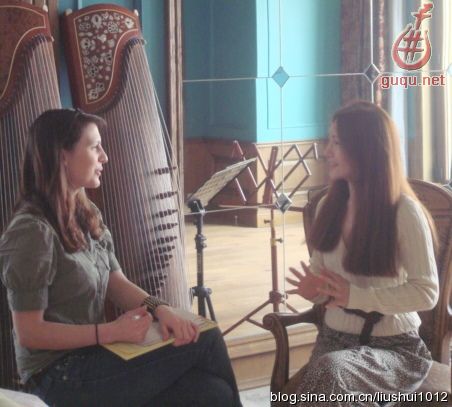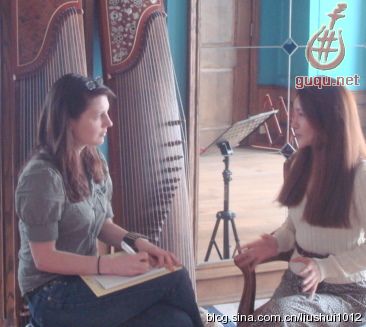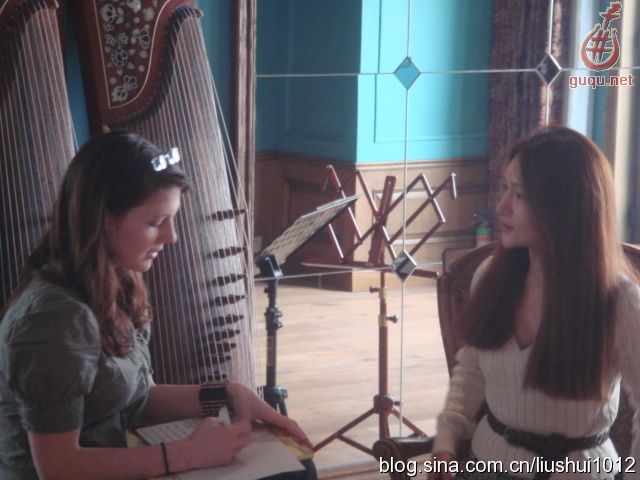-
吉炜
点击率:
热
- 发表评论
近日吉炜老师接受美国记者Lauren Johnson专题采访。古筝音乐在现代尤其近年深受海内外朋友喜爱,也受到美国媒体的关注,在去年年底开始的美国中国文化季期间,吉炜老师就受邀在美国进行古筝中国艺术交流。以下是记者lauren女士对吉老师的采访全文及中文翻译。
Gu Zheng Performer Highlights Beijing’s Musical Talent
By: Lauren Johnson
Ji Wei, Beijing ’s premiere gu zheng musician, is releasing a new album in the coming months that is aptly titled ‘Spring.’ Her passion and commitment to music, and to bringing ancient Chinese sounds to a modern, international audience continues to make her one of the most globally sought after gu zheng players.
“The gu zheng has an amazing sound that you can’t find in Western instruments.” Ji says. “ But this doesn’t mean it is destined to be performed only in Chinese solos. “To get a modern sound you have to change your technique,” she explains, “I have trained myself to play at new speeds, and create new sounds” that can be performed on the international stage.
Ji recently worked with Swedish performer Anders Miolin, fusing the Eastern gu zheng with the Western 13 string guitar. The resulting music spans two cultures and brings new emotions to the surface. She has worked with international orchestras and ensembles over the years, and explains that “most people really enjoy the instrument and are interested in my music.”
Ji’s proudest moments as an artist come from successfully performing as a concerto soloist with a large orchestra supporting her. The difficulty of blending an instrument that is about 3,000 years old with modern instruments can be overcome beautifully, and the resulting music is timeless.
“People don’t think the gu zheng can be balanced in an orchestra, but it is my responsibility to encourage composers to write new pieces for my instrument and to show that it can be expressive and balanced in a big orchestra.” And she has done just that. Her performances include an Argentine tango piece that aired for Global Chinese Grand New Year Concert 2011 . Making the gu zheng accessible to a wider audience is part of Ji’s mission as an artist and performer.
Ji’s upcoming album took over a year to record, compile and compose. It has something for everyone, including classical Chinese music, renaissance pieces and even a few modern adaptations.
Although she is busy with performances, international travel and recording her latest album, Ji finds time to give back to the music community. “I teach at the Central Conservatory of Music,” she says, “it is the best music school in China .” With over 15 one-on-one students, Ji is paving the way for a resurgence in the popularity of the gu zheng.
“ Beijing has many talented musicians, and the best music programs in China .” Ji exclaims, adding that her Spring album was inspired by Beijing .
Like many in China , Ji got her start very early in life when her parents decided to have her trained as a gymnast. Owing to the popularity of the sport, the classes were full so they took her instead to a music academy where the instructors were instantly struck by how classical and traditional the four-year-old Ji acted and looked. They admitted her to the school and suggested she be taught the ancient art of the gu zheng.
Speaking on the early start she had to her successful music career, Ji reminisces: “My mother made a gu zheng out of paper, with the strings drawn on so I could learn the scales and notes. I played on this paper gu zheng for half a year before we finally bought a simple sixteen string instrument.” The instrument was rare and hard to find, and Ji’s parents encouraged her to practice daily.
Ji performs monthly, mostly at the NCPA or internationally. Her upcoming album ‘Spring’ will be released in the coming months and will be available at music stores across the country. You can learn more about her at www.jiwei.org.
Gu Zheng Performer Highlights Beijing’s Musical Talent
By: Lauren Johnson
吉炜,北京杰出的著名古筝演奏家,将于近期发行一张名为“春天”的新专辑,吉炜老师对古筝音乐的执着与热情,以及一直致力于将中国传统音乐融入现代,并传播给国际各地的听众。这一切努力使得她成为世界最具探索精神的古筝演奏家之一。
“ 古 筝有着独特的,在西方乐器里找不到的声音”,吉老师说,“但是这并不意味着古筝只能演奏传统独奏作品。为了让它展现出现代的音乐气质及内容,你必须要拓展你的演奏技巧”她解释道,“必须训练自己挑战新的演奏速度,及创造出丰富的音色”,以使它能融入到国际音乐的舞台上并绽放光彩。
吉老师最近正在和瑞典吉他大师安德斯·米奥林合作,通过东方的古筝和西方的13弦的吉他的配合进行演奏,这种音乐形式的结合跨越了两种文化,为已有的音乐注入了新的活力。另外这些年来她一直在同许多的国际乐团和合奏团体合作演出。
“非常多的人喜欢古筝这件乐器,对我的音乐也很有兴趣”她说。
吉炜在演奏生涯中最享受的事情,就是作为古筝协奏曲的独奏家,和一个很大的交响乐团作为协奏给与古筝古筝这件乐器最好的音乐上的合作。让这个有着3000年历史的古筝同这些西方管弦乐器融合在一起是件容易的事,也深具挑战,但经历多次实践结果的音乐之魅是永恒的。
“人们普遍认为古筝同交响乐团合奏很困难,很难找到音响上的平衡,但我的责任是鼓励作曲家为我的古筝创作及改变一些优质的作品,通过这些音乐作品向人们展示古筝是完全胜任与交响乐合作并从中中到音响音色的平衡及互补关系的,并且还会有意想不到的效果。
她就是这样做的。如她在2011年全球华人新春音乐盛典中演奏皮亚索拉的探戈作品等, 让更多的观众能够了解古筝是她作为一个艺术家和演奏家的使命之一。
吉老师即将发行的这张即将发行的新专辑,从选曲、改编、创作、排练、录音、制作等花费了长达一年的时间,这张精心制作的专辑包括中国古典音乐作品,文艺复兴作品和一些现代的创作曲目。
她除了忙于演奏、国际演出、录制新专辑外,还在中央音乐学院担任专业导师。“它是中国最好的音乐学院”她说。
除了大概15个在校专业学生一对一的教学课程外,吉老师还在为古筝能够重新焕发光彩而作准备,“北京有很多优秀的音乐家,并且有中国最好的剧院”吉说,很多人在期待“春天”这张专辑。
吉老师4岁那年,她的父母决定让她学习舞蹈或体操以锻炼身体素质,但机缘巧合最终父母决定让她到音乐学校学习,音乐学院的指导老师立刻被这个孩子的古典气质和一个幼童能透出的传统感觉而折服,决定录取这位孩子,并且建议她学古筝。
这个乐器在那个年代很难找到,“我的妈妈用纸做了一个古筝,画上弦,所以我可以用它练习音阶和音符,”她回想说,”大概用这把琴练习了半年多才最终买了一架真正意义上的古筝。”
吉老师每月都有演出,大部分在国家大剧院或者国外。
音乐专辑信息
专辑“春天”即将在唱片店有售,或者在网站 www.jiwei.org可了解关于她的更多信息。



